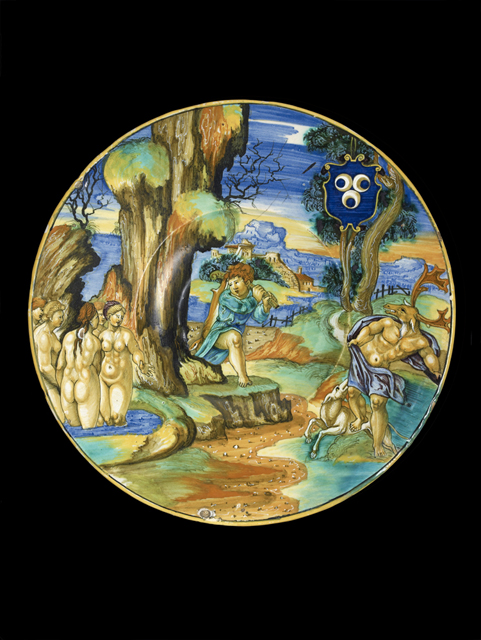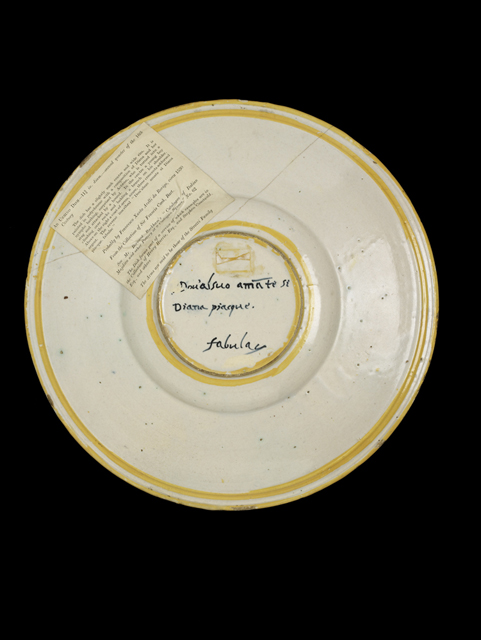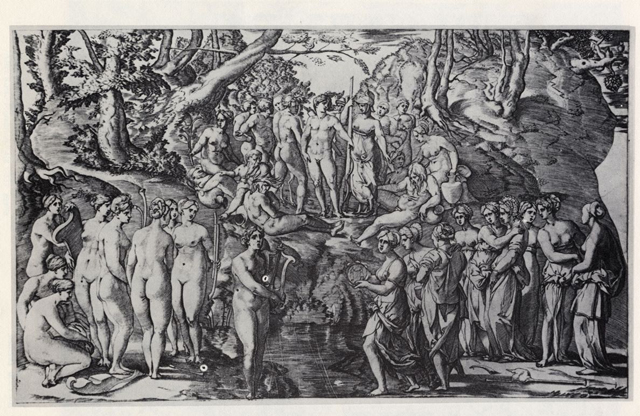Browse Collection
7 of 236

Plate with Diana and Actaeon
Avelli Francesco Xanto
Urbino, c. 1530
29.cm (diameter)
tin-glazed earthenware (maiolica)
This plate is an outstanding example of the work by the most interesting character in the history of Renaissance maiolica. Francesco Xanto Avelli came from Rovigo, near Padua, and had settled in Urbino by 1530. There, between 1530 and 1542, he painted a stream of works which he signed and dated more regularly than any other maiolica artist. He aspired to be a man of culture and a poet, and there is a manuscript of a sonnet sequence written by him in praise of Francesco Maria Della Rovere, Duke of Urbino, in the Vatican Library. He seems to have been a specialist painter, rather than a workshop owner like Nicola da Urbino or Guido Durantino, and his choice of a subject matter for maiolica is eccentric and ambitious, including allegories of contemporary politics and subjects from Classical history.
Inscribed on the reverse, Dov'alsuo am?te si Diana piacque. fabula (where Diana pleased her lover. A fable). Following the word fabula are two strokes of the brush resembling a y which are often found on work by Xanto in this period. Its significance, if any, has been much discussed; it may possibly represent "etc.".
At the bottom, between 6 o’clock and 7 o’clock, is a patch where the glaze has pooled away from the earthenware body; this "crawling" can easily happen with tin-glaze pottery if dust or grease settles on the vessel before it is dipped in the glaze.
Like many of Xanto's inscriptions this is an echo of Petrarch (Rime 52), a poet he evidently knew well. The story of Actaeon, from Ovid's Metamorphoses, book 3, was the most popular of all Classical stories among Renaissance maiolica painters. After a day spent hunting, Actaeon chanced upon Diana bathing with her attendants in a sacred grove. The goddess saw him and transformed him into a stag so that he could not relate to anyone that he had seen the chaste Diana naked. Actaeon was subsequently killed by his own hounds. In a manner typical of the artist, the design is a composite creation with figures taken from a number of diverse print sources. The group of Diana and her attendants is derived from an engraving of The Muses and the Pierides by Gian Giacomo Caraglio, while the figure in the centre comes from an engraving by Agostino Veneziano, after Raphael, of Isaac blessing Jacob [see illustration]. For other versions of the story see WA1941.13 and WA1888.CDEF.C444.
The arms have been variously interpreted; a plausible suggestion is that they are those of the Buoncristiani family of Florence, though it has also been argued that they are for the Strozzi family. The plate is from one of the earliest Urbino istoriato sets to carry the arms of a patron. Other pieces from the same service, some of which are by the "Milan Marsyas Painter" (see WA1888.CDEF.C442 and LI206.18) and have the crescents in a different arrangement, are listed in the late Jörg Rasmussen's catalogue of maiolica from the Lehman Collection. One plate is dated 1530. More recently the service has been reconsidered by Julia Triolo and others.
Lent from a private collection. LI192.1

Click to hide image
Other Images

Click to hide image

Click to hide image

Click to hide image

|

|

|